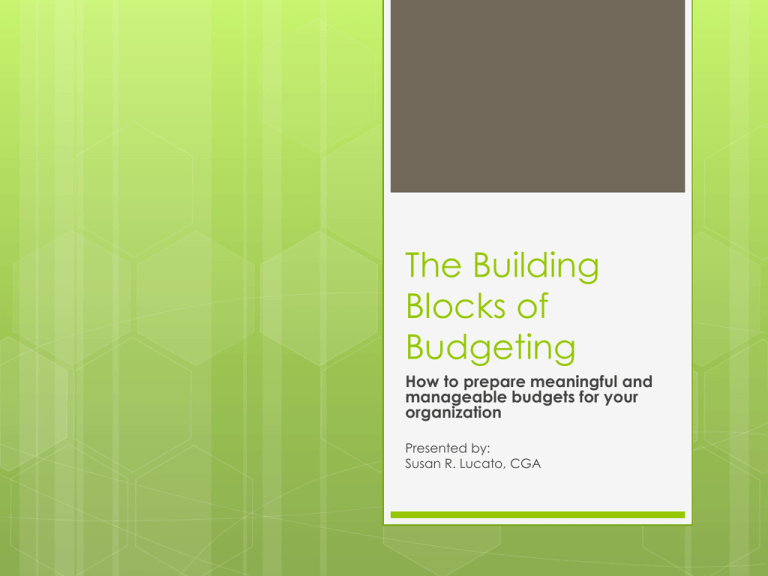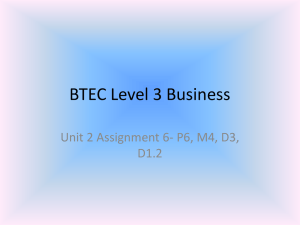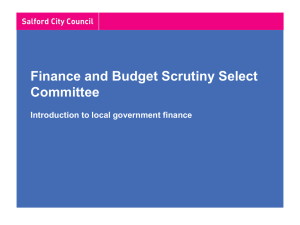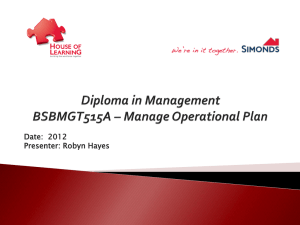What you need to know about Non-Profits
advertisement

The Building Blocks of Budgeting How to prepare meaningful and manageable budgets for your organization Presented by: Susan R. Lucato, CGA Susan Lucato, CGA 14 Years Grant Thornton Chartered Accountants 9 Years Victoria Foundation 2 Years consulting practice Active local volunteer www.susanlucato.com Presentation materials will be on-line TODAY The Building Blocks of Budgeting: Definition Development – steps in the process Budgeting process Best Practices Preparation Components Key terms / terminology and other important considerations What is a Budget? “A budget is the numerical expression of an organization’s dreams that serves as a guide or measure of acceptable financial performance.” Jody Blazek from Financial Planning for Non-Profit Organizations What is a Budget? A well constructed operating budget will demonstrate in numbers the organization's commitment to fulfilling its mission. It will be based on reliable income projections and expense projections will be wellresearched, conservative, and thorough. Those building the budget will understand what components of it are fixed and which can be adjusted as the budget year progresses. Steps for Developing a Good Budgeting Process - Overview Write it down. Decide who should be involved and when. Establish an annualized timeline. List specific tasks with specific responsibility assignments. Ensure that budget line items and accounting line items are in sync. Develop worksheets, templates, and tools that promote inclusion of all relevant budget components and facilitate "what if" scenarios. Budgeting Process The annual budgeting process should be documented, with tasks, responsibility assignments and deadlines clearly stated. A good budgeting process: engages those who are responsible for adhering to the budget in the creation of the budget, allows time for the Finance Committee to participate, provides adequate time for research, review, feedback, revisions, etc. before the budget is ready for presentation to the full board, Budgeting Process (cont’d) incorporates strategic planning initiatives, is characterized by realistic projections for income and expense is income-based (expenses do not exceed the realistic income projections) identifies fixed (indirect) costs and relates them to reliable revenue, is driven both by mission priorities and fiscal accountability Best Practices - Budgeting 1. 2. 3. 4. 5. 6. 7. Practice income-based budgeting Analyze and understand your revenue concentrations Confirm your budget's relationship to your mission and long range/strategic goals Don't forget infrastructure Budget for capital in addition to operations Provide narrative notes to explain budget assumptions to the board Pay attention to presentation Who is the budget for? EVERYONE in the organization – culture Who prepares – key staff, ED and Treasurer Who reviews – Finance Committee Who approves – Board of Directors Who is ultimately responsible – Board of Directors NOTE – key staff who prepare budgets should have their performance reviews include the results that are IN THEIR CONTROL Budget Preparation - Steps 1. Key staff, usually accountant / bookkeeper prepare draft budget documents based on prior year and known upcoming commitments 2. Key staff and ED meet to review draft and add / subtract items based on ED’s knowledge of upcoming year 3. Key staff, ED and Treasurer meet to review draft after changes in #2 have been made – further changes based on board strategic initiatives and Treasurer feedback 4. DRAFT Budget goes to Finance Committee for review & comments Budget Preparation - Steps 5. Changes updated by key staff 6. Final DRAFT approved by Finance Committee, “The Finance Committee recommends the budget be presented to the Board of Directors for approval” 7. Board reviews, questions and approves budget 8. FINAL APPROVED BUDGET saved in electronic files, all other versions should be removed, this budget is NOT changed again during the year. Approved Budget Approved Budget vs. Year-end Forecast A budget is a forecast or financial plan made at a point in time with the best information at hand. As an organization progresses further into the budget year, it only makes sense that better information will become available that would change the previously expected outcome in one or more line items. However, unless there has been a truly major change in the organization's structure or programs, it is generally not a good practice to change a budget once a budget has been approved by the board. It is better to create a column on financial reports that shows a Year-End Forecast, or Year-End Projection, based on the new information, and to explain any significant variances from the original budget. Budget line items and Accounting line items - MATCH A mismatch between budget items and accounting items creates extra work for administrative staff or key volunteers who must translate between the two and risks inconsistencies that undermine the usefulness of financial reports. Especially for expenses, when accounting/financial statement line items exist without corresponding budget line items, it can result in budget overages or erroneously reported line item balances. Budget components Organization budget: Operating Capital Department / Project budgets: Income Capital THESE ROLL INTO ORGANIZATION BUDGET Work part-to-whole The format of the budget to be presented to the board need not have the level of detail that staff or finance committee members see. Using detail worksheets as tools to build a "Full Budget" and a "Summary Budget" allows staff and finance committee members to go deep into the trees while presenting the forest to the board. Link these worksheets, or workbook tabs, to a Full Budget sheet in a single, multi-tab workbook. Later we’ll look at some examples in EXCEL BREAK TIME – 15 min Operating Budget Associated with Statement of Revenues & Expenditures(Income Statement, Profit & Loss) Planning income and expenses for a single fiscal year to accomplish immediate mission agenda Can be projected over multiple years as part of a strategic plan to include implementation of strategic initiatives Operating Budget - Revenues Associate fixed costs with reliable revenue Contractual income, income from term investments, committed grants, committed donations Fundraising events, applied for but unconfirmed grants = NOT reliable Ensure your committed revenues cover your fixed costs Fixed (indirect) costs = rent, payroll, telephone & technology – anything you spend regardless of whether a program runs this year or not FIXED = The cost to keep your doors open! If your reliable revenue doesn’t cover your fixed costs – you could find yourself in financial difficulties. Exercise – take away Take your organization’s operational budget and try to split the costs between direct and indirect. Then, take the indirect costs and calculate the % of indirect costs / reliable income. This percentage will help guide you as you grow your reliable income stream and when you are applying for funding. Exercise – take away i.e. Organization A: Reliable funding of $2 million per year Indirect costs of $500K per year Percentage 25% This is the percentage you could include in grant applications Budget components – ideas Supporting Year over year staffing history Year over year income history Fixed (indirect) vs. Variable (direct) Fundraising events, plans, history realistic, analyses: & conservative Ongoing commitments (rent) mid-budget year increases, moves etc. Direct / Indirect Costs Direct Costs Direct costs relate to a specific project or program. Indirect Costs or Overhead Indirect costs (sometimes called Overhead or General Administration) do not relate solely and specifically to a particular project or program, but are necessary to its completion. A formal indirect cost rate can be calculated and negotiated for some grant proposal budgets when allowed by the funder. Overhead is a vital budget component for all projects, whether specifically funded or not, and should certainly be taken into account along with direct costs as funding request budgets are composed. Indirect Costs Question to ask – does the expense stop if the program stops? Some costs are allocated across programs, but overall are still indirect – would you lay off the ED if a program was cancelled – likely not - this is an indirect cost. Rent – same premise – would you be able to lease less space if a program were cancelled – NO – indirect cost. Capital Budget Associated with Statement of Financial Position (Balance Sheet) Planning for optimal cash position (operating & emergency reserves, other strategic reserves) Planning for capital investments (equipment upgrade/replacement, facilities acquisition and/or maintenance, special projects, etc. over a longer time period) Planning for long term endowment (if appropriate) Non-profit – a misnomer! Nonprofits are in fact businesses whose profits (surpluses) remain with the (non-profit) corporation rather than going to individuals or shareholders as in the for-profit business model "not-for-profit" does not mean "no surplus allowed" Nonprofits need operating reserves. Operating reserves or working capital funds create liquidity and financial flexibility for the organization. Organizations with a strong working capital position can focus beyond day-to-day cash flow needs and more effectively plan for the long-term health of the organization. Capital Budget – Operating Reserve Funds Organization can be thrown into cash flow stress Become distracted from good long-term decisionmaking or forced to make expensive short-term crisis-based decisions May not have the resources to continue delivery of its programs Organizations with limited or negative working capital by necessity focus on the short term and are less likely to engage in responsible long-term planning. Building operating reserves is a top priority. Example – Internal Restrictions/ Contingency Funds Removes “operating surplus” excesses Rainy day source of operational funding OR savings for planned expenditures COMMON names: Building R&M Fund Capital Purchases Fund Operating contingency Fund Operating Reserves – Plan Set a target each year – much like a Strata Plan does – i.e. 1% of reliable revenues Make the building of a long-term reserve just as much of a priority as the short-term funding of your project(s) Build the “expense” of the reserve into your operating budget – bottom line Create recurring board motion to approve funds - $ doesn’t need to physically move – operating reserve is an appropriation of surplus Project / Department Budgets It’s important to understand that often staff preparing and managing these may not have a strength in this area – often this results in these budgets being prepared quickly, without care and lacking the back-up information to support the assumptions underlying the numbers. Project / Departmental Budgets Support from bookkeeper/controller is essential Review by bookkeeper/controller is essential Consistency between departments (format) Consistency of reporting (to finance dept) Accountability is KEY Project / Department Budgets Detailed Realistic Manageable Based on past results and current strategic initiatives Beware optimism – reliable funding Embrace caution – variable funding Team approach – ED, project team, finance Project / Dept Budgets Must “feed into” operational budget Timing – incorporate into annual budget planning process Staff preparing need to be fed certain pieces of information – such as salary allocation of staffing – they should NOT be provided with detailed staffing information Project / Dept Budgets Based on realistic income – prove income estimates in budget document – scan supporting information and include in presentation to controller & ED Research expenses under your control Get estimates of expenses from controller for other items you do not control i.e. Overhead allocation, staffing Budgets for Grant Applications Most grant-makers will request both a general operating budget and special project budget (if applicable). Budgets are cost projections. They are also show the funder how your project will be implemented and managed. Good budgets reflect carefully planned projects. Budgets for Grant Applications Include your organization’s YE financial statement Include specific notes and explanations, just as you would if explaining to your finance committee or board Include direct costs / overhead Review of Budget Results Controller to ED and Treasurer – detailed results Finance Committee Distribution – detailed results Feedback – all above involved Board of Directors Distribution – summary results Treasurer presents results Finance Committee and key staff support Review of Budget Results High dependence on non guaranteed income sources (fundraising, grants) Significant, unexplained changes in expenses – particularly large % expenses. I.e. Don’t focus on a $200 change in a $1,000 account – focus on a $20,000 change in a $100,000 account – both are 20% - so think before you spend time on immaterial items. Significant, unexplained changes in revenues Mission drift – too many new programs – loss of core programs and other issues Year upon year of deficits – it’s not a bad thing to be a non-profit with a profit! Review of Budget Results Line of Credit balance Unsecured debt Un-secured investments (stocks, bonds) Related party amounts (to/from employees or related orgs) Capital Asset balances – are they relatively current – I.e. Is a write-down in value warranted? Inventory – was a count performed – by whom and when? External and Internal Restrictions Review of Budget Results TIMING: Budget to actual results – quarterly is a good habit, monthly is too often UNLESS you are in a period of financial uncertainty Delays in reporting may indicate lack of experience in finance department – this is an important area of continuing education for staff (as well as board) Vocabulary Assets, in general, are possessions having value. In accounting, assets are resources owned, or in some cases controlled, by an individual or organization as a result of transactions or events from which future economic benefits are expected to flow to that individual or organization. Contributions are non-reciprocal transfers to a not-for-profit organization of cash or other assets or non-reciprocal settlements or cancellations of its liabilities. Government funding, grants and donations provided to a not-for-profit organization are considered to be a contributions. Current assets are those assets that are in the form of cash, or expected to become cash within the coming year. Current liabilities are those obligations that have to be paid within the coming year. Vocabulary Net assets, sometimes referred to as equity or fund balances, is the residual interest in a not for-profit organization’s assets after deducting its liabilities. Net assets may include specific categories of items whose use may be either restricted or unrestricted. Restrictions are stipulations imposed that specify how resources must be used. External restrictions are imposed from outside the organization, usually by the contributor of the resources. Internal restrictions are imposed in a formal manner by the organization itself, usually by resolution of the board of directors. Vocabulary Fixed costs are not ordinarily affected by the number of projects, programs, plays, workshops, or classes given or clients served. Examples of fixed costs: permanent fulltime staff, office rent, principal & interest payments on a longterm loan. Variable costs are usually project-oriented and are more controllable or adjustable. Examples: number of characters in a play, number of participants served by a program, number of weeks a program runs, number of exhibitions or concerts, local or international, additional space rental requirements, etc. Semi-variable costs are in between - these must happen but can be mitigated somewhat. Examples: choosing color vs. black & white for a print job, bulk ordering of necessary items, short-term rental vs. purchase of equipment, engaging part-time temporary help rather than hiring fulltime permanent staff, etc. Vocabulary Non-cash Budget Items Depreciation is a way to spread the expense of a large capital purchase over the number of years it will be in use In-Kind Contributions In-kind contributions are net-zero. That is, the contribution and the expense are equal, so they do not affect the bottom line net income, but they do increase the magnitude of the income and expenses. When budgeting for in-kind contributions, it is extremely important to ensure that the in-kind expenses are budgeted as well as the income. It would not be a good thing to balance a budget with non-cash income covering cash expenses. Thank you! Check out my website: www.susanlucato.com for resources and copies of today’s presentation Articles of Interest www.bdo.ca/en/Library/Industries/not-for-profit/pages/UnderControl-Proper-Financial-Controls-Can-Protect-YourNonprofit.aspx Under Control: Proper Financial Controls Can Protect Your Nonprofit www.cica.ca Various publications for the non-profit sector – free downloads Publications tab www.nonprofitaccountingbasics.org Various publications, articles and advice on running the financial side or your non-profit organization Sources & Resources Non-profit Accounting Basics www.nonprofitaccountingbasics.org Canada Revenue Agency Volunteer Victoria www.cra-arc.gc.ca www.volunteervictoria.bc.ca Charity Village Imagine Canada www.charityvillage.com www.imaginecanada.ca Office of the Information and Privacy Commissioner for BC BC Societies Act www.oipc.bc.ca www.bclaws.ca/EPLibraries/bclaws_new/document/ID/freeside/00_96433_01






